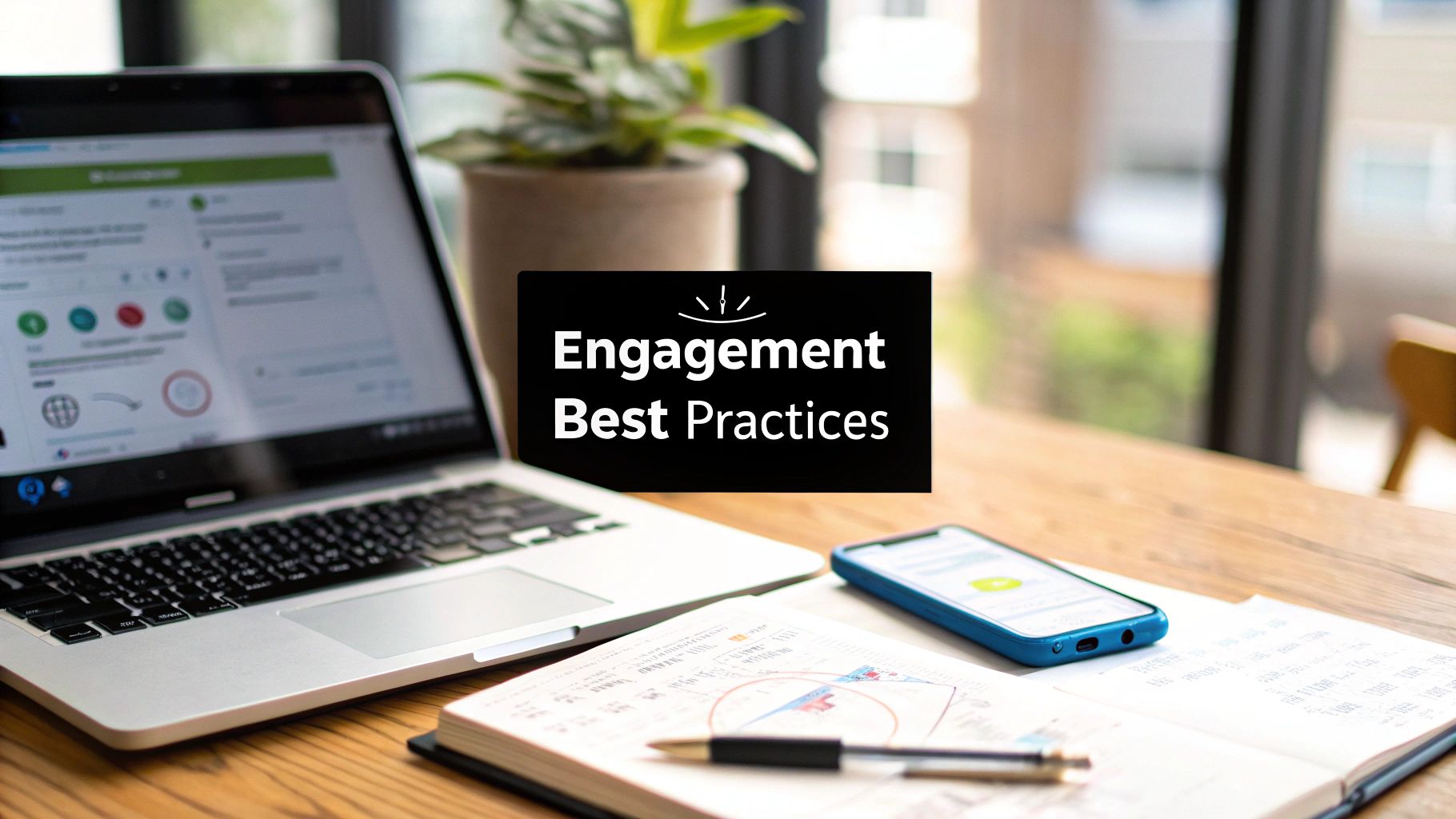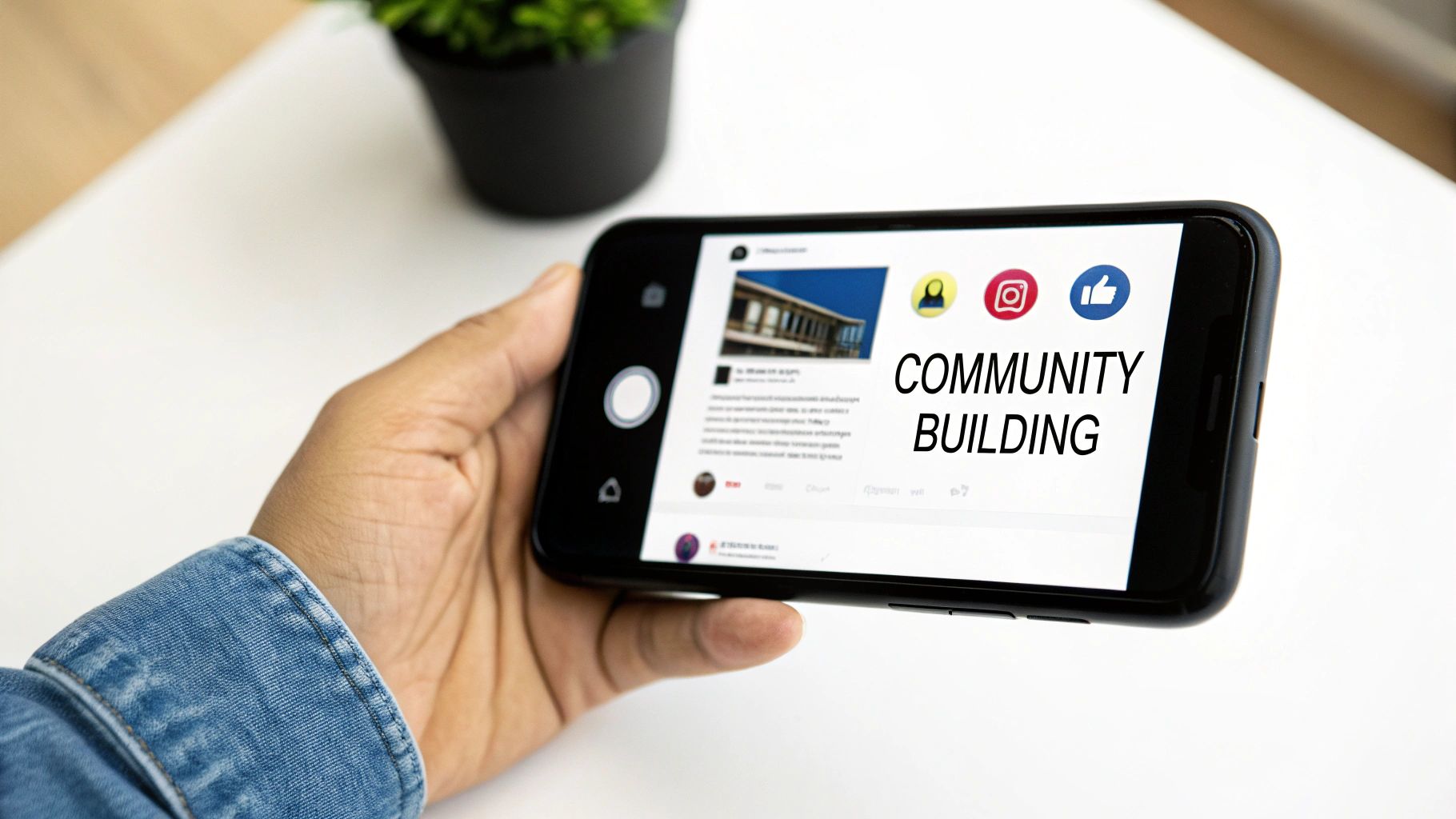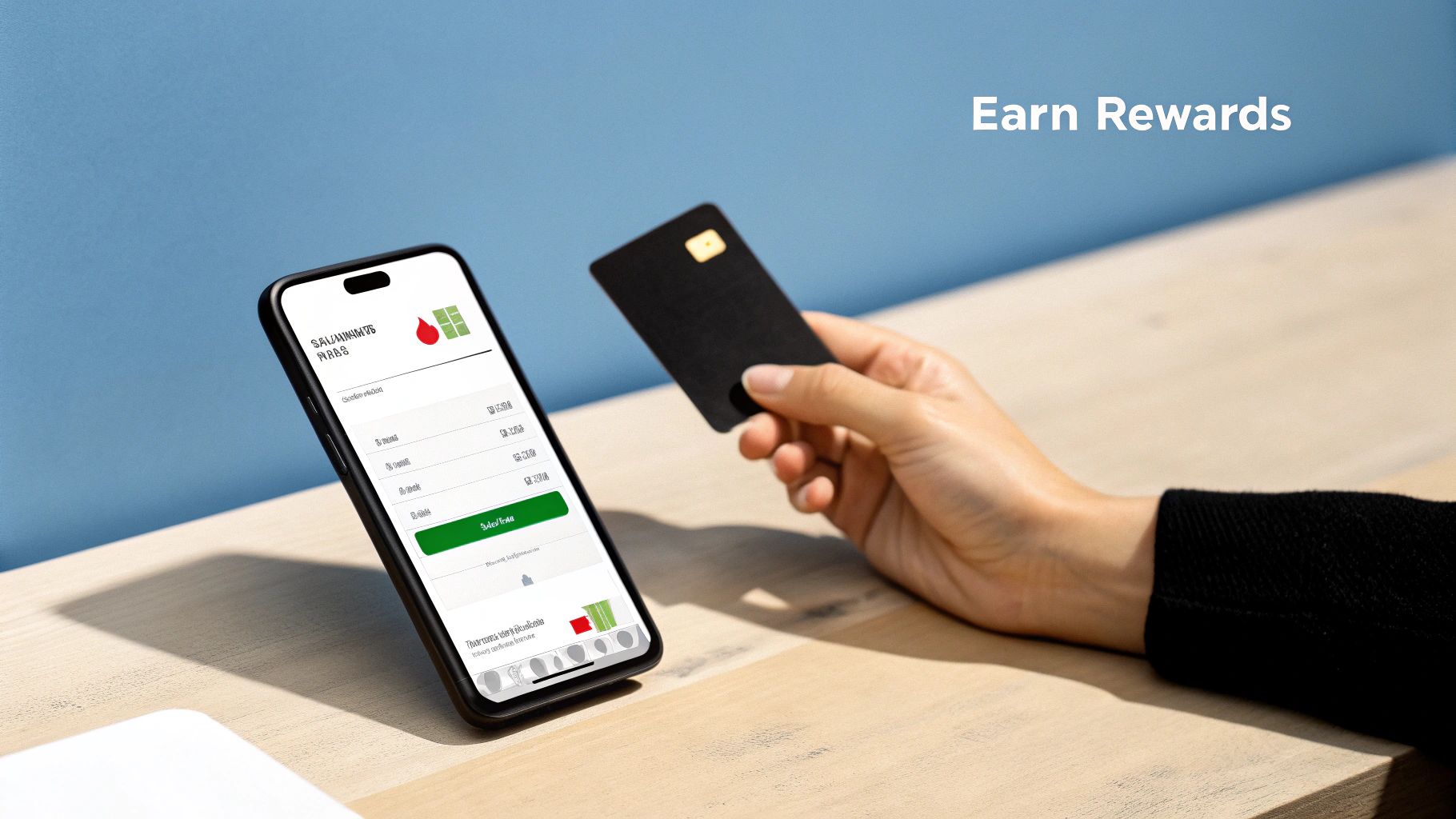
10 Customer Engagement Best Practices for 2025
Published on 2025-09-16
In a world saturated with options, the single greatest competitive advantage is a deep, meaningful connection with your audience. Standard marketing tactics are no longer enough; businesses must actively engage customers at every touchpoint, creating experiences that feel personal, responsive, and valuable. Success is no longer measured just by transactions but by the strength of the relationships you build. For a deeper dive into overarching strategies that underscore why customer engagement is non-negotiable, refer to this a comprehensive guide to improving customer engagement.
This guide moves beyond the buzzwords to deliver 10 proven customer engagement best practices that drive loyalty, foster advocacy, and build a resilient brand. We will explore specific, actionable strategies designed for immediate implementation. You will learn how to:
- Create a seamless omnichannel experience.
- Leverage data for personalization at scale.
- Implement proactive customer service that anticipates needs.
- Build a thriving community around your brand.
We'll provide the blueprint to transform passive consumers into passionate fans and achieve sustainable growth. Each point is packed with real-world examples and practical steps, giving you the tools to create meaningful connections that last. Let's get started.
1. Omnichannel Customer Experience
An omnichannel customer experience creates a seamless and unified journey for your audience, regardless of how or where they choose to interact with your brand. Unlike a multichannel approach, which simply offers multiple channels, omnichannel integrates them. This means a customer can start a conversation on a social media DM, continue it via email, and finalize a purchase in-store, with all context and history carried over effortlessly. This strategy is one of the most powerful customer engagement best practices because it puts the customer at the center of the experience, eliminating friction and frustration.

This approach makes customers feel understood and valued, fostering loyalty and deeper engagement. Disney, for example, mastered this with its MagicBand system, which links park tickets, hotel room keys, and payment methods into one cohesive experience, all connected to their mobile app.
How to Implement an Omnichannel Strategy
To build an effective omnichannel experience, start by understanding your customer's complete journey.
- Map Customer Touchpoints: Identify every point of interaction, from your website and social media profiles to physical stores and customer service calls.
- Integrate Your Technology: Invest in a robust Customer Relationship Management (CRM) system like Salesforce to unify customer data from all channels into a single, accessible view.
- Train Your Team: Equip your staff with the tools and training needed to access customer history and provide consistent support across different platforms. For instance, a support agent should be able to see a customer's recent live chat conversation when they call in.
- Audit for Consistency: Regularly review all channels to ensure branding, messaging, and service quality are perfectly aligned.
2. Personalization at Scale
Personalization at scale involves using data, AI, and machine learning to deliver tailored experiences, content, and recommendations to individual customers. This moves beyond basic segmentation (like addressing a customer by their first name) to anticipate needs based on their behavior, purchase history, and preferences. Implementing customer engagement best practices like this shows customers you understand them as individuals, not just as numbers in a database.

This strategy creates a more relevant and engaging journey, dramatically increasing conversion rates and loyalty. Amazon mastered this by creating a unique homepage for every user, while Spotify's Discover Weekly playlist uses listening habits to recommend new music with incredible accuracy, making users feel uniquely catered to.
How to Implement Personalization at Scale
To effectively personalize customer experiences without feeling intrusive, focus on collecting and using data responsibly.
- Start with Rich Data Collection: Gather data from multiple touchpoints, including website clicks, past purchases, and support interactions, to build comprehensive customer profiles.
- Leverage AI and Machine Learning: Use AI-powered tools to analyze customer data and automate personalized recommendations, content delivery, and product suggestions.
- Ensure Data Transparency: Be clear with customers about what data you are collecting and how you are using it. Provide easy options for them to manage their preferences.
- Test and Refine Continuously: Use A/B testing to experiment with different personalization elements, such as email subject lines or product recommendations, and use the results to refine your algorithms.
3. Proactive Customer Service
Proactive customer service involves anticipating customer needs and reaching out with solutions before they even realize a problem exists. Instead of waiting for a customer to contact support with an issue, this approach uses data and monitoring to identify potential friction points and address them ahead of time. This strategy is one of the most effective customer engagement best practices because it transforms the service experience from reactive problem-solving to a demonstration of genuine care and foresight.

This method builds immense trust and loyalty by showing customers you are looking out for them. For example, Uber notifies riders of driver delays and sometimes offers credit, while airlines like Southwest proactively rebook passengers when flights are cancelled. This turns a potentially negative situation into a positive, brand-affirming interaction.
How to Implement Proactive Customer Service
To effectively anticipate and solve customer issues, you need to leverage data and empower your team.
- Use Data to Predict Issues: Analyze customer data and support tickets to identify common problems that arise at specific points in the customer journey. For instance, if many new users get stuck on a certain feature, create an automated in-app guide that triggers at that point.
- Set Up Automated Monitoring: Implement systems that alert your team to potential problems, such as a bank automatically flagging suspicious account activity or an e-commerce platform notifying a customer of a shipping delay.
- Create Tiered Communication: Develop a plan for how and when to communicate. A minor software bug might warrant a simple in-app notification, while a major service outage requires emails, social media updates, and a status page.
- Train Your Team: Empower support staff to identify opportunities for proactive outreach during their regular interactions and provide them with the autonomy to offer solutions without waiting for a complaint.
4. Social Media Engagement and Community Building
Social media engagement and community building involve creating a space where customers can connect with your brand and each other. This goes beyond simple marketing posts and focuses on fostering authentic conversations and relationships. By building an active community, you turn passive followers into brand advocates. This strategy is one of the most effective customer engagement best practices because it creates a sense of belonging and transforms your social channels into valuable brand assets.

This approach makes customers feel like they are part of something bigger, strengthening their emotional connection to your brand. For instance, GoPro’s entire marketing strategy is built on its community, showcasing incredible user-generated content that both engages existing customers and attracts new ones. Similarly, Glossier built its beauty empire by listening to and co-creating products with its dedicated online community.
How to Build a Social Media Community
To build an engaged social media community, you must prioritize authenticity and value over direct sales pitches.
- Define Your Brand Voice: Establish clear guidelines for your brand's personality and tone to ensure all communications are consistent and authentic.
- Encourage User-Generated Content (UGC): Actively ask customers to share their experiences using a specific hashtag. Feature the best submissions on your channels to make followers feel seen and appreciated.
- Be Responsive and Personable: Respond promptly and thoughtfully to comments, questions, and mentions. Show the human side of your brand, like Wendy's does with its witty and engaging Twitter presence.
- Create Valuable Content: Consistently produce content that educates, entertains, or inspires your audience. To learn more about creating engaging social media posts, you can explore tips on making AI carousels on autoghostwriter.com.
5. Customer Feedback Loop Implementation
Implementing a customer feedback loop is about creating a systematic process to collect, analyze, and act on customer input, then communicating those actions back to your audience. This two-way dialogue shows customers you are listening and that their opinions directly shape your business. Instead of feedback disappearing into a void, it becomes a catalyst for tangible improvement, making it one of the most effective customer engagement best practices for building trust and demonstrating value.
This proactive approach turns customers into active partners in your brand's evolution. Slack, for example, excels at this by allowing users to submit feature requests and then providing regular updates on what they’re building based on that input. This not only improves the product but also makes users feel invested in its success.
How to Implement a Customer Feedback Loop
To build a system that genuinely drives improvement, focus on the complete cycle from collection to communication.
- Use Multiple Feedback Channels: Capture diverse opinions by using a mix of surveys (like NPS or CSAT), online reviews, social media listening, and direct communication channels.
- Systemize Analysis and Prioritization: Create a clear process for your team to analyze incoming feedback, identify trends, and prioritize which suggestions to act on. To streamline the collection and analysis of customer input, consider choosing the right customer feedback management software to manage this process.
- Respond and Acknowledge: Make it a policy to respond to feedback promptly, even if it's just to acknowledge receipt. When appropriate, respond publicly to reviews to show transparency.
- Close the Loop: This is the most critical step. Actively communicate the changes and improvements you've made based on customer suggestions through email newsletters, blog posts, or in-app notifications.
6. Loyalty Programs and Gamification
Loyalty programs and gamification transform repeat business into an engaging and rewarding experience. This strategy incentivizes customers to continue interacting with your brand by offering structured rewards like points, tiers, and exclusive benefits. By adding game-like elements such as badges, challenges, and leaderboards, you make participation more enjoyable and compelling. This is a core component of modern customer engagement best practices because it builds habitual interaction and strengthens emotional connections to your brand.
This approach gives customers a tangible reason to choose you over competitors, fostering a sense of community and achievement. A prime example is Sephora's Beauty Insider program, which not only rewards purchases with points but also offers experiential perks like early access to products and beauty classes, making customers feel like valued insiders.
How to Implement Loyalty Programs and Gamification
To launch a program that truly resonates with your audience, focus on creating value and making participation feel effortless.
- Align Rewards with Customer Values: Go beyond simple discounts. Offer rewards that your customers genuinely desire, whether it's exclusive content, early access, or unique experiences.
- Make It Simple and Transparent: Ensure the rules for earning and redeeming points are easy to understand. A complicated system can deter participation. The Starbucks Rewards app excels at this with its clear star-earning structure.
- Incorporate Gamification Elements: Introduce challenges, badges for achievements, or progress trackers to make the experience more interactive and fun. Nike’s Run Club app successfully uses this to motivate users with achievement badges and community challenges.
- Personalize the Experience: Use customer data to send personalized offers, challenges, and reward notifications that are relevant to their specific interests and purchase history.
7. Data-Driven Customer Insights and Analytics
Leveraging data-driven insights means using customer analytics to understand preferences, predict behavior, and make informed decisions. This practice moves beyond guesswork, allowing you to tailor your strategies based on what the data actually says your customers want. By analyzing everything from purchase history to website clicks, you can uncover patterns that lead to more meaningful interactions. This is one of the most crucial customer engagement best practices because it transforms raw information into actionable intelligence.
This approach allows companies to proactively meet customer needs, often before customers even articulate them. Netflix famously uses viewing data to not only recommend shows but also to greenlight original content it predicts will be a hit. Similarly, Target's predictive analytics famously identified expectant parents based on their purchasing habits, allowing for timely and relevant marketing.
How to Implement Data-Driven Insights
To effectively use data, you need a clear process for collecting, analyzing, and acting on it.
- Define Your Goals: Start by identifying what you want to learn. Are you trying to reduce churn, increase repeat purchases, or improve content? Clear questions lead to clear answers.
- Integrate Your Data Sources: Consolidate information from your CRM, website analytics, and social media platforms into a single view. Tools like Google Analytics and HubSpot are essential for this.
- Invest in Visualization: Use dashboards and reporting tools like Tableau or Power BI to make complex data easy to understand. Visual reports help teams quickly spot trends and opportunities.
- Train Your Team: Equip your staff to interpret data and translate insights into action. For more information, you can learn more about content performance analysis to see how data informs strategy.
8. Content Marketing and Storytelling
Content marketing and storytelling move beyond direct selling to build relationships by providing value. This approach involves creating and sharing relevant, consistent content that educates, entertains, or inspires your audience. By weaving authentic stories into your content, you can create powerful emotional connections, establish brand authority, and foster a loyal community. This strategy is one of the most effective customer engagement best practices because it builds trust and keeps your brand top-of-mind.
This method makes your brand a go-to resource rather than just a product or service provider. Red Bull, for example, has become synonymous with extreme sports not by advertising its drink, but by creating and funding exhilarating content that captivates its target audience. Similarly, HubSpot attracts customers by offering a massive library of free educational blogs, guides, and courses.
How to Implement Content Marketing and Storytelling
To engage customers through content, focus on solving their problems and telling compelling narratives.
- Solve Customer Problems: Develop content that directly addresses your audience's pain points and answers their most common questions. Use keyword research to understand what they are searching for.
- Develop a Brand Voice: Create a consistent and authentic storytelling style that reflects your brand's personality. Whether it's humorous, inspiring, or technical, stick to it across all channels.
- Use Customer Stories: Incorporate genuine testimonials, case studies, and user-generated content to build social proof and make your brand more relatable. Authentic stories resonate far more than corporate messaging.
- Repurpose Content: Maximize your efforts by adapting a single piece of content, like a blog post, into multiple formats such as a video, infographic, or social media series. Discover more about crafting your narrative with these business storytelling examples.
9. Mobile-First Customer Experience
A mobile-first customer experience involves designing your entire digital presence with mobile devices as the primary focus. Rather than creating a desktop site and shrinking it down for phones, this approach prioritizes the user experience on smartphones and tablets from the very beginning. This strategy is one of the most critical customer engagement best practices today, as the majority of consumers now discover, research, and purchase on their mobile devices. It ensures your brand is accessible, fast, and easy to interact with on the go.
This focus on mobile creates an intuitive and frictionless journey, which directly boosts engagement and conversions. Uber, for example, built its entire service around a seamless mobile app, allowing users to book a ride, track their driver, and pay with just a few taps. This convenience is a key driver of its widespread adoption and customer loyalty.
How to Implement a Mobile-First Strategy
To build an effective mobile-first experience, you must think and design from the smallest screen up.
- Prioritize Page Loading Speed: Optimize images, leverage browser caching, and minimize code to ensure your site loads almost instantly on mobile connections.
- Use Thumb-Friendly Design: Place key navigation elements and call-to-action buttons within easy reach of a user's thumb. Ensure buttons are large enough to be tapped accurately.
- Optimize Forms for Mobile: Keep forms short and simple. Use mobile-friendly input types like number pads for phone numbers and date pickers for appointments.
- Test Across Multiple Devices: Regularly test your website and app on a variety of popular smartphones and tablets to ensure a consistent and functional experience for all users.
10. Customer Success and Onboarding Excellence
Customer success and onboarding excellence focuses on ensuring customers achieve their desired outcomes right from the start. A structured onboarding process guides new users to value quickly, reducing churn and building a foundation for long-term relationships. This proactive approach transforms the initial interaction from a simple transaction into a partnership, making it one of the most effective customer engagement best practices for creating loyal advocates.
This strategy prevents new users from feeling overwhelmed or failing to see the product's value. Slack, for instance, provides comprehensive guides and interactive tutorials during setup to help teams communicate effectively from day one. This level of support ensures customers are not just using the product, but succeeding with it, which directly drives deeper engagement and retention.
How to Implement Customer Success and Onboarding Excellence
To build a program that ensures customer success, you must create a clear and supportive path from signup to proficiency.
- Map the Journey to "First Value": Identify the key steps a new user must take to experience the core benefit of your product. Design your onboarding flow to guide them through these actions as efficiently as possible.
- Create Milestone-Based Onboarding: Break down the learning process into small, manageable steps with clear progress indicators. Use checklists or progress bars to motivate users and show them how far they’ve come.
- Offer Diverse Learning Formats: Cater to different learning preferences by providing a mix of video tutorials, written guides, interactive walkthroughs, and live webinars.
- Assign Dedicated Success Managers: For high-value accounts, provide a dedicated customer success manager (CSM) to offer personalized guidance, proactive support, and strategic advice.
- Measure and Optimize: Track key metrics like onboarding completion rates, time-to-first-value, and feature adoption. Use this data to identify friction points and continuously refine the experience.
Top 10 Customer Engagement Practices Comparison
| Item | Implementation Complexity 🔄 | Resource Requirements ⚡ | Expected Outcomes 📊 | Ideal Use Cases 💡 | Key Advantages ⭐ |
|---|---|---|---|---|---|
| Omnichannel Customer Experience | High - requires extensive tech integration and staff training | Significant technology and integration efforts | Increased satisfaction, loyalty, higher conversions | Businesses with multiple customer touchpoints | Consistent experience, better data insights |
| Personalization at Scale | High - involves AI, ML, and data infrastructure | High investment in data management and AI technologies | Higher engagement, lifetime value, competitive edge | E-commerce, streaming, targeted marketing | Tailored experiences, improved conversions |
| Proactive Customer Service | Moderate to High - needs predictive analytics and monitoring tools | Investment in monitoring systems and AI alerts | Reduced effort, fewer support tickets, cost savings | Industries with frequent predictable issues | Problem prevention, improved loyalty |
| Social Media Engagement & Community Building | Moderate - requires continuous content creation and monitoring | Content creation teams and social management tools | Increased brand awareness, viral potential | Brands focused on community growth and advocacy | Direct feedback, cost-effective marketing |
| Customer Feedback Loop Implementation | Moderate - setup of multi-channel collection and analysis | Tools for surveys, sentiment analysis, and action tracking | Improved product/service based on direct feedback | Customer-centric companies focused on continuous improvement | Data-driven decisions, increased loyalty |
| Loyalty Programs and Gamification | High - complex reward structures and technology platforms | Significant operational and technology investment | Increased retention, purchase frequency, engagement | Retail, subscription services, frequent buyers | Enhanced engagement, valuable data |
| Data-Driven Customer Insights & Analytics | High - requires data infrastructure and skilled analysts | High cost for tools and personnel | Targeted marketing, better decision-making | Data-centric organizations across industries | Predictive insights, ROI optimization |
| Content Marketing and Storytelling | Moderate - continual content creation and strategy execution | Skilled content creators and marketing resources | Brand trust, improved SEO, emotional connections | Brands building authority and customer education | Long-term brand equity, cost-effective growth |
| Mobile-First Customer Experience | Moderate - focus on mobile optimization and app development | Specialized mobile development skills | Higher mobile conversions, better UX | Businesses prioritizing mobile users | Fast, seamless mobile interactions |
| Customer Success and Onboarding Excellence | Moderate to High - structured workflows and support systems | Investment in success teams and automation tools | Reduced churn, higher adoption, increased value | SaaS, complex product adoption | Customer retention, proactive success management |
Turning Insights into Action: Your Next Steps in Customer Engagement
We’ve journeyed through ten foundational customer engagement best practices, from building a seamless omnichannel experience to mastering mobile-first design. Each strategy, whether it’s implementing proactive customer service or leveraging data-driven analytics, serves as a crucial building block for creating a brand that customers don't just buy from, but truly connect with. The common thread weaving through all these tactics is a shift in perspective: moving from transactional interactions to relational, value-driven partnerships.
The goal isn't just to be present on multiple channels; it's to be consistent and helpful everywhere your customer is. It’s not just about collecting feedback; it's about closing the loop and showing customers their voices lead to tangible change. Similarly, personalization at scale is no longer a futuristic concept but a present-day expectation, powered by the very data your customers entrust you with. Mastering these concepts means understanding that engagement is the engine of loyalty, and loyalty is the bedrock of sustainable growth.
From Blueprint to Reality: Making It Happen
Reading about these strategies is the first step, but the real transformation begins with action. The sheer number of possibilities can feel overwhelming, so the key is to start small, be strategic, and build momentum. Don't try to overhaul your entire customer experience overnight. Instead, focus on incremental, high-impact changes.
Here’s a simple, actionable framework to get you started:
- Audit Your Current State: Begin by evaluating where you stand. Which of the ten practices are you already doing well? Where are the most significant gaps? Use customer surveys, analytics, and team feedback to get an honest assessment.
- Prioritize One or Two Initiatives: Based on your audit, select one or two practices that align with your immediate business goals. If customer churn is high, focus on Customer Success and Onboarding Excellence. If your social channels are quiet, prioritize Community Building and Social Media Engagement.
- Set Clear, Measurable Goals: Define what success looks like for your chosen initiative. This could be increasing your Net Promoter Score (NPS) by 10%, reducing customer service response times by 20%, or boosting engagement rates on your primary social platform.
- Execute, Measure, and Iterate: Roll out your new initiative, track your progress against your goals, and be prepared to adapt. Customer engagement is not a "set it and forget it" activity. It requires continuous attention and refinement based on real-world results and evolving customer expectations.
Ultimately, adopting these customer engagement best practices is about committing to a culture of customer-centricity. It’s a promise to listen, a commitment to improve, and a dedication to delivering value at every single touchpoint. The brands that thrive in the modern marketplace are the ones that earn their customers' attention and loyalty, one meaningful interaction at a time. The blueprint is in your hands; now is the time to start building.
Struggling to create the high-quality, engaging content needed to power your customer engagement strategy? autoghostwriter can help you generate insightful articles, social media posts, and newsletters that resonate with your audience. Visit autoghostwriter to see how our AI-powered platform can streamline your content creation and help you implement these best practices with ease.